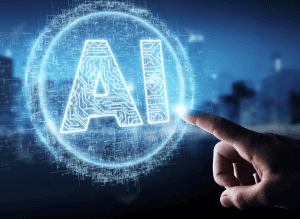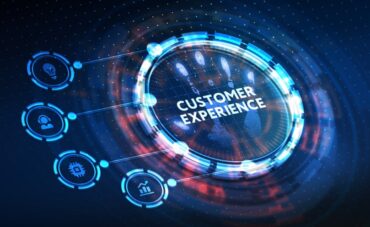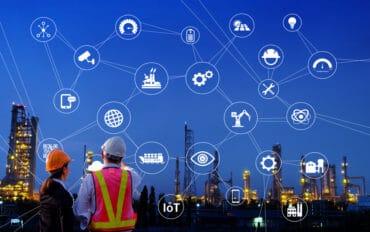
2022 promises to see industrial AI turn a major new corner in how the manufacturing sector draws on AI applications to tackle the problems of the day.
For many years now, we’ve heard and read about how “next year” will be the breakout year for AI. And in a way, that’s always true – each year marks a new level-up in AI’s ability to optimize traditional business operations and streamline work for the better. These year-after-year improvements have also further refined AI, for more fit-for-purpose applications that drive new value in specific use cases. Industrial AI is the latest iteration of this phenomenon, applying AI’s processing to specialized applications in a manufacturing world rapidly undergoing profound digital transformations.
Just as 2020 and 2021 marked new evolutions in artificial intelligence, 2022 promises to see industrial AI turn a major new corner in how the manufacturing sector draws on AI applications to tackle the problems of today and create new value-adding layers to their organization and ways of working. Coming off two years of pandemic and economic uncertainty, here are four ways we can expect industrial AI to reshape the manufacturing landscape in 2022.
See also: How AI Will Make Industry 4.0 Profitable
1) Generational workforce changes will accelerate knowledge automation
Workforces across all industries are undergoing major, tectonic shifts. This is especially true in the industrial sector. Veteran employees are hitting retirement age, the Great Resignation is affecting workers across many industries, and just filling the labor gap with new recruits fresh out of school won’t do the trick – often, these new graduates come to the job having learned technologies and concepts in school that don’t match the reality of how many organizations’ workflows and systems on the plant floor actually operate.
All of this will prompt a major acceleration of knowledge automation technologies and processes in 2022. Automated knowledge sharing and intelligence-rich applications close the skills gap emerging between departing workers and brand new ones, by preserving historic domain knowledge and making it widely accessible across teams, regardless of silos. This has the dual benefit of serving as a recruiting tool, as well; the more that knowledge automation makes work easier and gives employees the tools they need to succeed, the more appealing the job becomes to potential recruits.
2) Industrial data scientists emerge to facilitate industrial AI strategy
The generational churn occurring in the industrial workforce will inspire another trend: the widespread emergence of industrial data scientists as central figures in adopting and managing new technologies, like industrial AI – and just as importantly, the strategies for deploying and maximizing these technologies to their full potential. New research revealed that while 84% of key industrial decision-makers accepted the need for an industrial AI strategy to drive a competitive advantage – and 98% acknowledged how failing to have one could present challenges to their business – only 35% had actually deployed such a strategy so far. With one foot in traditional data science and the other in unique domain expertise, industrial data scientists will serve a critical role in being the ones to drive the creation and deployment of an industrial AI strategy.
3) AI investments shift from generic models to more precise industrial AI
2022 will see AI’s maturation into industrial AI reach full bloom, graduating to real-world product deployments with concrete time-to-value. To achieve this, we’ll see more industrial organizations make a conscious shift from investments in generic artificial intelligence models to more fit-for-purpose, precise industrial AI applications that help them achieve their profitability and sustainability goals. This means moving away from AI models that are trained on large volumes of plant data that can’t cover the full range of potential operations to more specific industrial AI models that leverage domain expertise for interpreting and predicting with deep analytics and machine learning. Industrial data will be transformed into real business outcomes across the full asset lifecycle.
This shift will have the dual benefit of also facilitating new best-of-breed alliances built around industrial AI. Previously, partnerships were very tech-centric, driven by services or one large vendor. The more specialized focus of industrial AI will require a larger set of solutions providers, pooling together their independent and customized expertise. Not only does this help evolve partnerships away from more generic AI projects, but it will also place a greater focus on time-to-value partnerships as opposed to do-it-yourself approaches, helping to lower the barrier to AI adoption more than ever.
4) Executive ownership and cultural change will accelerate industrial AI deployments
As industrial organizations scale up their deployments of enterprise-wide industrial AI strategies and applications, executive ownership and an investment in cultural change will be critical in reaping the benefits of digital transformation. Digital executives like Chief Digital Officers will be crucial to overcoming these obstacles. CDOs will have a unique role to play in shepherding digital transformation and industrial AI through their organization – bridging the gap between legacy systems and new technologies, fostering collaboration across silos, and shifting from mass data collection to strategic industrial data management. All of these duties will be essential to ensure that an industrial organization can execute a digital transformation plan that sees wider adoption of, and strategy around, fit-for-purpose industrial AI applications.
As industrial businesses begin to transition from planning their 2022 roadmap to actually executing that vision, making industrial AI a key part of that strategy is crucial. Generational workforce trends, the growing role of artificial intelligence projects, and cultural changes around digital transformation will only continue apace. Pretending otherwise will only get you stuck behind the curve. Staying competitive in the new year means embracing and capitalizing on these changes through knowledge automation, industrial data scientists, and fit-for-purpose industrial AI applications.





























